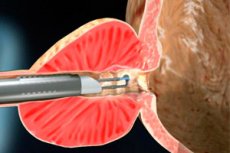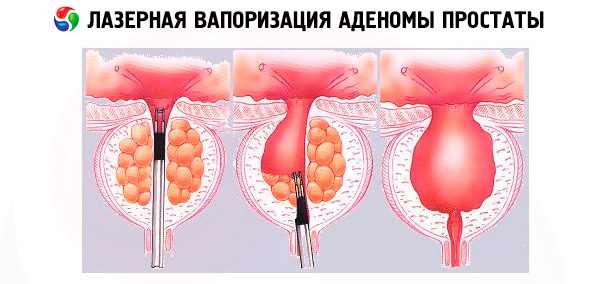Medical expert of the article
New publications
Prostate vaporization: laser, plasma
Last reviewed: 06.07.2025

All iLive content is medically reviewed or fact checked to ensure as much factual accuracy as possible.
We have strict sourcing guidelines and only link to reputable media sites, academic research institutions and, whenever possible, medically peer reviewed studies. Note that the numbers in parentheses ([1], [2], etc.) are clickable links to these studies.
If you feel that any of our content is inaccurate, out-of-date, or otherwise questionable, please select it and press Ctrl + Enter.

With age, many men experience an enlargement of the prostate gland and are diagnosed with benign hyperplasia, which causes problems with urination. And today, one of the methods of its treatment is endoscopic vaporization of the prostate.
What is it? In relation to urology, this is a local effect on the enlarged tissues of the gland of a focused flow of thermal or high-energy photons that destroy the covalent bonds of atoms in protein molecules of prostate tissue, oxyhemoglobin and extracellular fluid, as a result of which the atoms lose their electron shells and become positively charged ions, and the substance itself turns into a gas, that is, evaporates.
Indications for the procedure
Vaporization - transurethral electrovaporization, endoscopic laser or plasma - is performed for prostate adenoma, that is, benign hyperplasia of the prostate gland, which has reached a stage that is not amenable to other treatment methods.
Vaporization or removal of prostate adenoma with a laser is indicated in cases where its size does not exceed 80 mm.
Both clinical studies and reviews from practicing urologists confirm the advantages of these endourological minimally invasive techniques in comparison with open and laparoscopic prostatectomy or transurethral resection of the prostate gland.
 [ 1 ]
[ 1 ]
Preparation
Any patient can be prescribed prostate vaporization after its hyperplasia has been diagnosed during a full clinical examination with transrectal ultrasound, uroflowmetry and blood testing for prostate-specific antigen (PSA), as well as in the presence of symptoms corresponding to the International Prostate Symptom Score (IPSS).
Read more – Diagnosis of prostate adenoma
Preparation for the vaporization procedure itself involves taking a general blood test, a blood clotting rate test, a general urine test, and an ECG.
The patient must stop taking anticoagulants and heparin drugs two days before the scheduled operation, and food and liquids 10-12 hours before.
Technique prostate vaporization
Vaporization of prostate adenoma is performed through the urethra, that is, transurethrally - using a cystoscope, under local spinal anesthesia (sometimes under general anesthesia).
The technique of transurethral electrovaporization of the prostate consists of inserting an electrode through the urethra and moving it to the surface of the prostate gland. The electric current supplied through it heats and vaporizes the gland tissue; the affected area is washed with a physiological solution; at the same time, the blood vessels are coagulated and sealed. A catheter is installed for a day or two to drain urine.
Basic techniques of laser surgery of prostate adenoma include minimally invasive surgery under endoscopic control – laser vaporization of prostate adenoma or layer-by-layer removal of prostate adenoma with a laser, lasting no more than 50-60 minutes. Depending on the equipment used, the technique can be contact or contactless (with lateral beam direction through quartz caps STL, Ultraline, Prolase-I), used for larger adenomas.
For contact vaporization, high-power diode lasers such as YAG, Quanta System, GreenLight (KTP laser with a power of 60 W or LBO laser GreenLight HPS with a power of 80 W) are used – by direct contact of the tip of the light guide with the tissue. When the laser beam penetrates, thermal conversion of the laser energy occurs, which leads to an increase in the temperature of excess prostate tissue above the boiling point and its immediate evaporation.
Photoselective laser vaporization of the prostate (using the GreenLight XPS laser) uses several energy pulses lasting from 30 to 60 seconds, which destroy hyperplastic tissue of the prostate gland and reduce its size. This method is used even if patients have heart problems (since the anesthesia is local).

Bipolar plasma vaporization of the prostate in saline (bipolar plasmakinetic technology) is characterized by high clinical efficacy and a sufficient degree of safety – removal of prostate tissue using low-temperature plasma energy (produced by generators, such as the Olympus UES-40 Surgmaster), which is supplied through special devices that do not directly contact the prostate gland. Electricity flows between the electrodes, converting concentrated saline into a layer of plasma, which destroys tissue upon contact.
Plasma vaporization not only evaporates overgrown tissue, but also coagulates the remaining healthy tissue, leaving a smooth surface. Plasma vaporization with a button (mushroom) electrode of a spherical surface provides better coagulation. The operation is performed under epidural anesthesia.
Contraindications to the procedure
Contraindications to this operation include:
- infectious diseases;
- the presence of chronic inflammatory diseases of the urinary tract and pelvic organs;
- unstable cardiopulmonary status of the patient;
- recent myocardial infarction or coronary artery stent placement (in such cases, surgery is postponed for 3-6 months);
- severe coagulopathies (including congenital ones) requiring constant use of drugs to increase blood clotting;
- overactive bladder and/or lower urinary sphincter dysfunction;
- myasthenia, multiple sclerosis, Parkinson's disease;
- severe diabetes mellitus.
 [ 4 ]
[ 4 ]
Consequences after the procedure
Possible consequences after surgery include:
- impaired sperm flow, i.e. its reverse flow (to the bladder) or retrograde ejaculation, which reduces male fertility;
- erectile dysfunction;
- re-growth of the prostate gland (recurrence of benign hyperplasia) within a few months after surgery.
Complications after the procedure
Bleeding during and after laser and plasma vaporization is minimal, and the healing process is fast, but there may be complications after the surgery:
- temporary internal tissue swelling that makes urination difficult;
- minor pain in the urethra and suprapubic area;
- burning in the urethra (especially after removal of the catheter);
- hematuria (blood in the urine for several days to two weeks);
- frequent urge to urinate and partial incontinence;
- burning at the tip of the penis and discomfort at the end of urination (from two to six weeks);
- urinary tract infection;
- the formation of scar tissue in the urethra, causing its obstruction.
A complication of spinal anesthesia may include headache.
Care after the procedure
The recommendations of the specialists of the European Association of Urology for care after prostate vaporization are as follows:
- You should avoid physical activity (sports, heavy lifting, cycling) and sex for at least two weeks;
- do not take baths, do not visit swimming pools or swim in bodies of water;
- in case of pain, take painkillers or NSAIDs, and in case of inflammation, antibiotics prescribed by your doctor;
- temporarily avoid drinking coffee, tea, carbonated and alcoholic drinks, citrus juices, spicy and fatty foods;
- drink up to 1.5–2 liters of water daily during the first weeks after surgery;
- To avoid constipation, include more fiber in your diet.

